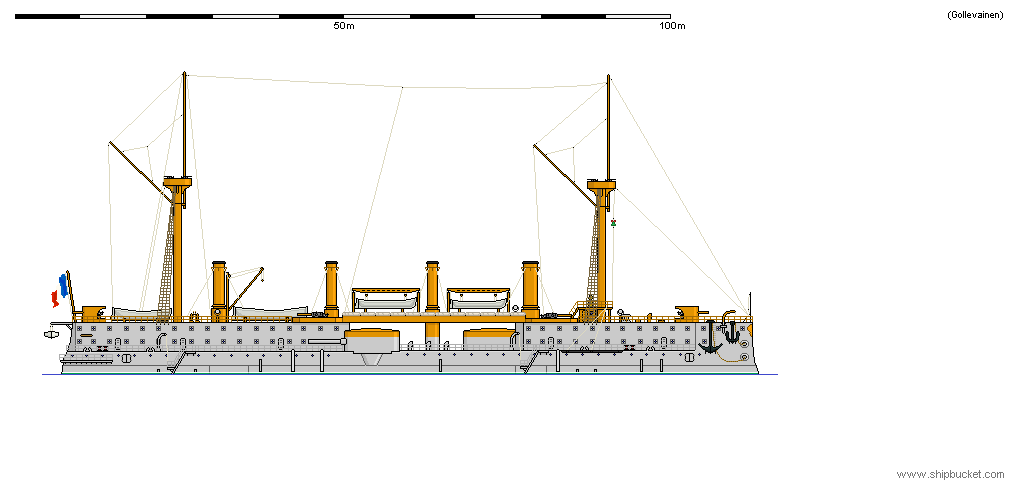W 1880 roku francuska marynarka wojenna rozpoczęła program rozbudowy floty, który obejmował m.in. 6 pancerników. Wśród nich były późniejsze Hoche i typ Marceau. Miały też być dwa kolejne okręty, które miały zostać zwodowane już w 1882 r., a ostatecznie nie powstały na skutek decyzji adm. Aube’a. Jeden z nich miał nosić nazwę Brennus, nazwa drugiego nie jest znana. Wg dostępnych informacji miały to być jednostki w typie Inflexible czy Duilio, czyli z uzbrojeniem głównym rozmieszczonym diagonalnie na śródokręciu, w dwóch wieżach. W tym czasie flota francuska odchodziła już od gigantycznych dział jak na typie Terrible, zatem miały na nie składać się 4 działa kal. 340 mm, prawdopodobnie o długości lufy 30 kalibrów (model z 1884 r.). Oprócz tego okręt miał mieć kilka dział średniego kalibru (zapewne 164 mm) oraz kilka lekkich działek przeciw torpedowcom (tu przyjąłem jednolufowe działka Hotchkissa kal. 37 mm (1-funtowe). Brak bliższych danych co do reszty parametrów jednostek, zatem są one całkowicie moją spekulacją. Okręt otrzymał pancerz stalowo-żelazny typu compound o grubości 450-230 mm na burcie, 400 mm na wieżach i barbetach, 150 mm na ścianach stanowiska dowodzenia oraz pancerz żelazny pokładu o grubości 40-75 mm. 2 silniki parowe o łącznej mocy 8500 KM rozpędzają okręt do 16 w.
Poniższe grafiki powstały z wykorzystaniem rysunku Gollevainen z forum shipbucket.
Brennus, french battleship laid down 1882 (Engine 1885)
Displacement:
10 174 t light; 10 622 t standard; 11 491 t normal; 12 187 t full load
Dimensions: Length overall / water x beam x draught
354,53 ft / 354,53 ft x 67,45 ft x 26,44 ft (normal load)
108,06 m / 108,06 m x 20,56 m x 8,06 m
Armament:
4 - 13,39" / 340 mm guns (2x2 guns), 1 091,31lbs / 495,01kg shells, 1884 Model
Breech loading guns in turrets (on barbettes)
on side, all amidships
2 - 6,46" / 164 mm guns in single mounts, 122,47lbs / 55,55kg shells, 1884 Model
Breech loading guns in deck mounts
on centreline ends, evenly spread, all raised mounts
4 - 6,46" / 164 mm guns in single mounts, 122,47lbs / 55,55kg shells, 1884 Model
Breech loading guns in deck mounts
on side, evenly spread, all raised mounts
8 - 1,46" / 37,0 mm guns in single mounts, 1,38lbs / 0,63kg shells, 1883 Model
Quick firing guns in deck mounts
on side, evenly spread, 4 raised mounts
Weight of broadside 5 111 lbs / 2 318 kg
Shells per gun, main battery: 75
5 - 15,0" / 380 mm submerged torpedo tubes
Armour:
- Belts: Width (max) Length (avg) Height (avg)
Main: 17,7" / 450 mm 168,54 ft / 51,37 m 8,99 ft / 2,74 m
Ends: 9,06" / 230 mm 185,99 ft / 56,69 m 8,99 ft / 2,74 m
Main Belt covers 73% of normal length
Main belt does not fully cover magazines and engineering spaces
- Gun armour: Face (max) Other gunhouse (avg) Barbette/hoist (max)
Main: 15,7" / 400 mm 11,8" / 300 mm 15,7" / 400 mm
2nd: 1,97" / 50 mm 1,18" / 30 mm -
- Armour deck: 2,20" / 56 mm (2,95" / 75 mm over amidships, 1,57" / 40 mm over ends), Conning tower: 5,91" / 150 mm
Machinery:
Coal fired boilers, complex reciprocating steam engines,
Direct drive, 2 shafts, 8 510 ihp / 6 348 Kw = 16,00 kts
Range 4 050nm at 10,00 kts
Bunker at max displacement = 1 565 tons (100% coal)
Complement:
554 - 721
Cost:
£1,124 million / $4,497 million
Distribution of weights at normal displacement:
Armament: 639 tons, 5,6%
Armour: 3 789 tons, 33,0%
- Belts: 1 881 tons, 16,4%
- Torpedo bulkhead: 0 tons, 0,0%
- Armament: 1 106 tons, 9,6%
- Armour Deck: 738 tons, 6,4%
- Conning Tower: 65 tons, 0,6%
Machinery: 1 654 tons, 14,4%
Hull, fittings & equipment: 4 092 tons, 35,6%
Fuel, ammunition & stores: 1 317 tons, 11,5%
Miscellaneous weights: 0 tons, 0,0%
Overall survivability and seakeeping ability:
Survivability (Non-critical penetrating hits needed to sink ship):
8 556 lbs / 3 881 Kg = 8,1 x 13,4 " / 340 mm shells or 1,4 torpedoes
Stability (Unstable if below 1.00): 1,08
Metacentric height 3,2 ft / 1,0 m
Roll period: 15,7 seconds
Steadiness - As gun platform (Average = 50 %): 59 %
- Recoil effect (Restricted arc if above 1.00): 0,53
Seaboat quality (Average = 1.00): 1,18
Hull form characteristics:
Hull has a flush deck
Block coefficient: 0,636
Length to Beam Ratio: 5,26 : 1
'Natural speed' for length: 18,83 kts
Power going to wave formation at top speed: 47 %
Trim (Max stability = 0, Max steadiness = 100): 50
Bow angle (Positive = bow angles forward): -35,00 degrees
Stern overhang: 0,00 ft / 0,00 m
Freeboard (% = measuring location as a percentage of overall length):
- Stem: 11,98 ft / 3,65 m
- Forecastle (20%): 11,98 ft / 3,65 m
- Mid (50%): 11,98 ft / 3,65 m
- Quarterdeck (15%): 11,45 ft / 3,49 m
- Stern: 11,45 ft / 3,49 m
- Average freeboard: 11,80 ft / 3,60 m
Ship tends to be wet forward
Ship space, strength and comments:
Space - Hull below water (magazines/engines, low = better): 93,8%
- Above water (accommodation/working, high = better): 73,6%
Waterplane Area: 18 085 Square feet or 1 680 Square metres
Displacement factor (Displacement / loading): 94%
Structure weight / hull surface area: 159 lbs/sq ft or 777 Kg/sq metre
Hull strength (Relative):
- Cross-sectional: 0,92
- Longitudinal: 2,11
- Overall: 1,00
Hull space for machinery, storage, compartmentation is adequate
Room for accommodation and workspaces is cramped
Brennus (1885)
Clovis (1886)
























